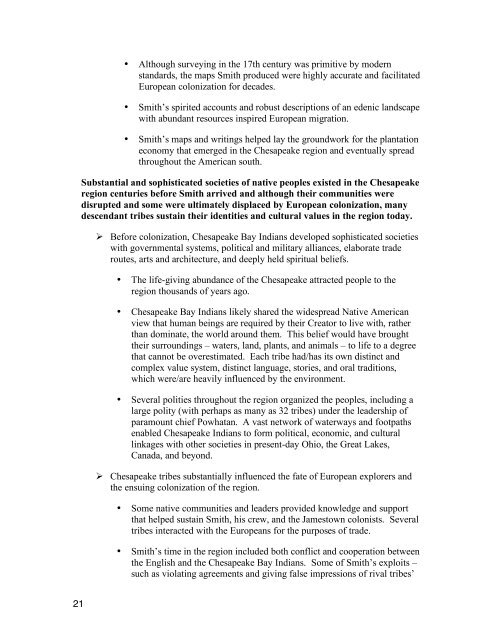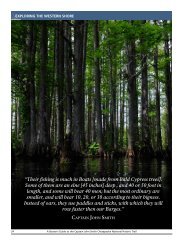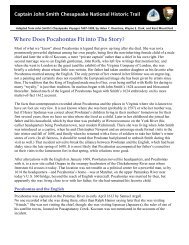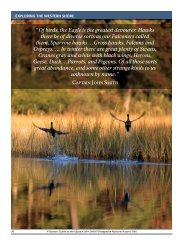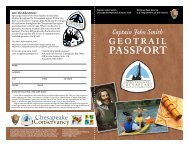Draft Interpretive Plan Join the adventure! - Captain John Smith ...
Draft Interpretive Plan Join the adventure! - Captain John Smith ...
Draft Interpretive Plan Join the adventure! - Captain John Smith ...
Create successful ePaper yourself
Turn your PDF publications into a flip-book with our unique Google optimized e-Paper software.
• Although surveying in <strong>the</strong> 17th century was primitive by modern<br />
standards, <strong>the</strong> maps <strong>Smith</strong> produced were highly accurate and facilitated<br />
European colonization for decades.<br />
• <strong>Smith</strong>’s spirited accounts and robust descriptions of an edenic landscape<br />
with abundant resources inspired European migration.<br />
• <strong>Smith</strong>’s maps and writings helped lay <strong>the</strong> groundwork for <strong>the</strong> plantation<br />
economy that emerged in <strong>the</strong> Chesapeake region and eventually spread<br />
throughout <strong>the</strong> American south.<br />
Substantial and sophisticated societies of native peoples existed in <strong>the</strong> Chesapeake<br />
region centuries before <strong>Smith</strong> arrived and although <strong>the</strong>ir communities were<br />
disrupted and some were ultimately displaced by European colonization, many<br />
descendant tribes sustain <strong>the</strong>ir identities and cultural values in <strong>the</strong> region today.<br />
Before colonization, Chesapeake Bay Indians developed sophisticated societies<br />
with governmental systems, political and military alliances, elaborate trade<br />
routes, arts and architecture, and deeply held spiritual beliefs.<br />
• The life-giving abundance of <strong>the</strong> Chesapeake attracted people to <strong>the</strong><br />
region thousands of years ago.<br />
• Chesapeake Bay Indians likely shared <strong>the</strong> widespread Native American<br />
view that human beings are required by <strong>the</strong>ir Creator to live with, ra<strong>the</strong>r<br />
than dominate, <strong>the</strong> world around <strong>the</strong>m. This belief would have brought<br />
<strong>the</strong>ir surroundings – waters, land, plants, and animals – to life to a degree<br />
that cannot be overestimated. Each tribe had/has its own distinct and<br />
complex value system, distinct language, stories, and oral traditions,<br />
which were/are heavily influenced by <strong>the</strong> environment.<br />
• Several polities throughout <strong>the</strong> region organized <strong>the</strong> peoples, including a<br />
large polity (with perhaps as many as 32 tribes) under <strong>the</strong> leadership of<br />
paramount chief Powhatan. A vast network of waterways and footpaths<br />
enabled Chesapeake Indians to form political, economic, and cultural<br />
linkages with o<strong>the</strong>r societies in present-day Ohio, <strong>the</strong> Great Lakes,<br />
Canada, and beyond.<br />
Chesapeake tribes substantially influenced <strong>the</strong> fate of European explorers and<br />
<strong>the</strong> ensuing colonization of <strong>the</strong> region.<br />
• Some native communities and leaders provided knowledge and support<br />
that helped sustain <strong>Smith</strong>, his crew, and <strong>the</strong> Jamestown colonists. Several<br />
tribes interacted with <strong>the</strong> Europeans for <strong>the</strong> purposes of trade.<br />
• <strong>Smith</strong>’s time in <strong>the</strong> region included both conflict and cooperation between<br />
<strong>the</strong> English and <strong>the</strong> Chesapeake Bay Indians. Some of <strong>Smith</strong>’s exploits –<br />
such as violating agreements and giving false impressions of rival tribes’<br />
21


